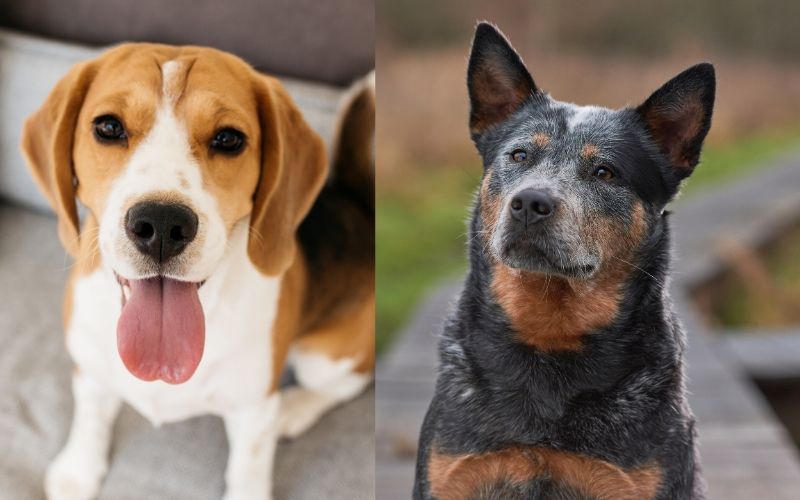The Beagle Cattle Dog is a mix of the Australian Cattle Dog (also called a Blue Heeler) and Beagle breeds. This mix has the energy and friendliness of its parents’ breeds, but also some of their headstrong tendencies. With proper training and care, it can make an excellent companion.

Appearance
Blue Heelers and Beagles have very different physical appearances, which means that any mix between the two breeds should produce quite a variety of looks. You can expect to find varying sizes and colors, even among pups in the same litter.
Weight & Height
As Beagles and Blue Heelers have quite different ranges for height and weight, the range for their offspring should be equally large. In general, it is likely to be between 13 and 20 inches (33 cm to 51 cm) tall and weigh somewhere between 20 and 45 pounds (9 kg to 20 kg).
Coat Color
The color of the Beagle Cattle Dog mix has a huge range of possibilities. Colors can include white, blue, brown, red, black, and tan. It is possible to have a speckled Cattle Dog coat, a ticked, spotted or marked Beagle coat, a tricolor coat, or any combination.

Coat Length & Thickness
This mix will likely have a short, smooth, thick coat with a dense double layer. Its top layer wicks off rain, protecting it from the weather. The coat’s thickness means it requires more brushing than other dogs. Be aware that the amount of brushing may cause your allergies to flare.
View this post on Instagram
Temperament
The Blue Heeler Beagle mix is said to inherit a high degree of intelligence from its Blue Heeler parent. It is energetic, affectionate and makes an excellent family dog if it is properly trained and cared for. As with all mixed breeds, it may inherit dominant traits from either parent.
View this post on Instagram
Does Not Like Being Alone
Both the Australian Cattle Dog and Beagle are social animals, both with humans and other dogs. As such, this mix requires lots of attention and love. Make sure to gradually condition it to your absence to lessen separation anxiety. Both parents are territorial, so expect it to be the same.
Could Bark, Chew and Dig if Bored
Beagles are well-known for their mournful howling, and Cattle Dogs have an intense, high-pitched bark. Both parents are known to play-bite and chew. Although training helps, when bored, your dog is especially likely to bark, chew, and dig, so you will need to keep it mentally stimulated.
Stubborn Personality but Needs Training for Certain Behaviors
The Beagle Cattle Dog mix will be stubborn. Both of its parents are stubborn, so there is no reason why this mix won’t be stubborn as well. Though this mix responds well to training, you will still need to monitor it for specific habits, like herding and nipping at heels.
Not Aggressive but Unruly if Untrained
While the Beagle Cattle Dog mix is unlikely to be aggressive, you might have troublesome behavior if it remains untrained, such as nipping, jumping, and food aggression. From the Australian Cattle Dog side, this mix also tends to bite at the heels of people or other pets to herd them.
Preferred Climate Is Warm Weather
Blue Heelers are adaptable and do well in cold, temperate and hot conditions, but Beagles prefer warmer weather. If your Beagle Cattle Dog mix has the typical short, thick coat, expect that warm weather will be the most suitable environment for your dog.
Companion or Suitability Factor
With proper training and attention, the Beagle Cattle Dog mix can be an excellent companion. It can coexist with other dogs, children, and large families. It is high-energy and thus not suitable for every lifestyle. As with all mixes, its individual disposition may be different than the “standard.”

Kid-Friendly with Caution
This mix is very affectionate and loyal. It loves to play, be pet, and rubbed. However, it may retain some instincts from its Blue Heeler side, meaning that it may nip at or “herd” members of the family. Make sure to address this behavior early on in training.
Is Not Apartment Friendly
The Blue Heeler Beagle mix requires a lot of exercise, and so is not ideal for apartments. Giving it lots of room to move and explore is vital to preventing it from becoming bored and unruly. Additionally, it can be very vocal, especially if its Beagle traits are dominant.
Not Ideal for Senior Citizens
While the Beagle Cattle Dog is an affectionate and loyal mix, its exercise requirements and high energy level make it a suboptimal choice for senior citizens. This type of mix does best with an owner who has the time, energy and ability to give it purposeful activity and mental stimulation.
Tends to Get Along with Other Pets if Trained Properly
While Beagles are happy to have other dogs as playmates, you may find your Blue Heeler Beagle mix to be inclined to “herd” them or other pets. This comes from its Blue Heeler parent’s strong herding tendencies, but can be largely corrected with training.
Training & Intelligence
Blue Heeler Beagles are reported to be highly intelligent and able to pick up on training quite easily. It enjoys new challenges and should be eager to engage in different activities. As it is prone to stubbornness, you may run into difficulties if you are a first-time dog owner.

Training Could Be Challenging
If your mix tends toward its Beagle parent’s disposition, you will likely find it difficult to train. Beagles are notorious for their stubbornness. You will need to establish yourself very early on as the alpha. Positive reinforcement and daily training will likely be necessary.
Intelligence
The Beagle Cattle Dog is said to be highly intelligent. That could be true because its one parent, the Australian Cattle Dog, ranks #10 for intelligence on Stanley Coren’s index of 138 breeds. However, do note that its Beagle parent ranks almost last at #131 out of 138 breeds.
Physical Needs
This Beagle Cattle Dog mix needs to maintain an active lifestyle. You can take it on walks, for jogs, or to a dog park. If your mix takes after its intelligent Blue Heeler parent, you will want to keep it mentally stimulated, for example, with interactive dog toys.
Eats a High-Quality Diet
The calorie requirements of your mix will depend on its weight and activity level. It should be fed in small meals to help prevent bloat. Its diet should be high in protein, such as chicken, beef, or rabbit, and possibly include supplements like glucosamine and chondroitin for its joint health.
Needs At Least 60 Minutes of Exercise Per Day
The Beagle should have 90 minutes of exercise daily, and the Blue Heel should have from 1-2 hours per day, so your mix needs at least 60 minutes to keep it healthy. Having a wide-open space for it to play is recommended, and its lifespan is 10 to 13 years.
View this post on Instagram
Shedding & Bathing
Blue Heeler Beagles are heavy shedders, so you will need to be prepared. Invest in the proper equipment, such as a high-quality brush and a vacuum for dog hair. You should brush daily, bathe about every three weeks, and regularly check their ears for signs of infection.
Background & Pricing for a Puppy
Like many designer mixes, the background of the Beagle Cattle Dog is not well known, and a discussion of its history focuses on that of its parents, the Australian Cattle Dog and the Beagle. Other names for this mix include the Blue Heeler Beagle and the Australian Cattle Dog Beagle.
Background
Australian Cattle Dogs, or Blue Heelers, originate from Australia. It is a working dog, very adept at herding cattle and other animals. It is said to have been bred with dingoes. It is uncertain where the Beagle originated, but it is an ancient dog. The modern Beagle originates from England.

Price for a Puppy
This type of mix is unpopular, and you are unlikely to find many breeders. The best place to start is your local animal shelter, which will screen your dog for certain health and behavioral information. Breeders charge around US$300 to US$1500, but adoption from a shelter is usually cheaper.
Health Issues
Every breed has health issues, and mixed breeds are often healthier because of the variety in their gene pools. The Blue Heeler Beagle mix is primarily at risk for four ailments from its Beagle side, and three from its Blue Heeler side.
Allergies & Skin Problems
Known as atopy, allergies in dogs most often affect their skin, typically the ears, feet, stomach, and any skin folds. It usually starts between 1-3 years old, and can be from allergens, pests, or be genetic. Symptoms include licking or rubbing the affected area. It may also lead to infections.
The best option for treating your dog’s allergies is to avoid the allergen or problem pest. Finding the source of the allergen/pest may be difficult, and will likely require a visit to the vet. You can also use medications prescribed by your vet to relieve the symptoms.
Obesity & Hypothyroidism
Hypothyroidism is a genetic thyroid disorder, most commonly characterized by lethargy and weight gain. You may also notice abnormalities in their skin or shedding. Middle-to-older aged dogs are most often affected. It can be a troublesome diagnosis, so make sure to see your vet if you are concerned.
While hypothyroidism can’t be cured, it can be managed with proper medications. After testing your dog’s blood, it will be prescribed medicine, and it will likely need to visit the vet for regular check-ups. Remain vigilant to limit the impact on your dog’s life.
Epilepsy
Epilepsy is similar to that in humans, characterized by seizures. It is, unfortunately, closely tied to genetics. As such, it is important to obtain the health background and parents’ history of your dog from the rescue shelter or breeder. Symptoms usually arise between when it is 1-5 years old.
It is vital to diagnose your dog early. The sooner you can begin antiepileptic treatments, the less likely your dog will have a dangerous episode. If your Blue Heeler Beagle mix suffers a seizure, you should see a neurologist as soon as you can to protect your dog.
Trick Knee (Patellar Luxation)
Patellar luxation is the dislocation of the kneecap. This is usually genetic and starts showing signs by the age of three. As it typically affects the hindlimbs, you will often see your dog lengthening its stride, favoring a certain hind leg, or even “skipping.”
As a predominantly genetic disorder, it is difficult to prevent. Avoiding jumping and getting your dog regularly checked is helpful. An x-ray can reveal whether it suffers from patellar luxation. Once diagnosed, surgery is the most common treatment. After the surgery, you will have to closely monitor your dog’s movement.
Eye Problems
There are several eye issues that this mix might develop when it ages, such as cataracts, glaucoma, and progressive retinal atrophy (PRA). Cataracts, primary glaucoma, and PRA are largely hereditary. Secondary glaucoma is typically caused by injury or infection. Glaucoma is painful, but cataracts and PRA are not.
Surgery often treats cataracts, but 40% of dogs with glaucoma become blind in the affected eye within one year regardless of treatment. Primary glaucoma is not preventable, but secondary glaucoma is. PRA is not treatable and results in blindness. Consider obtaining its ophthalmology test results before you purchase your dog.
Deafness (Congenital Hereditary Sensorineural Deafness)
Blue Heelers are genetically predisposed to deafness, and so might be your dog. Check your dog’s hearing if it doesn’t respond to the sounds you’d expect it to, like its name. Deafness can be detected by about six weeks of age, though it is more common in older dogs.
Your dog should be screened for deafness before you purchase it, and then checked regularly. If you notice any hearing loss in your dog, you should schedule an appointment with your vet. Safeguarding your dog from drug toxicity, chronic infections, and head injuries can help prevent geriatric deafness.
Hip Dysplasia
Hip dysplasia is a genetic disorder where the joints of the hips do not develop correctly. This can lead to difficulty with movement and a decreased activity level. While it may not present until the dog’s later years, it can also manifest even in puppyhood.
Depending on the severity, there are a wide variety of treatments available. If there is severe arthritis or other symptoms, surgery may be necessary. Physical therapy, a healthy diet, and moderation of certain activities might also be required. Before purchasing your dog, consider getting its hip score for each hip.
Brandon Miller has a B.A. from the University of Texas at Austin. He is a seasoned writer who has written over one hundred articles, which have been read by over 500,000 people. If you have any comments or concerns about this blog post, then please contact the Green Garage team here.
